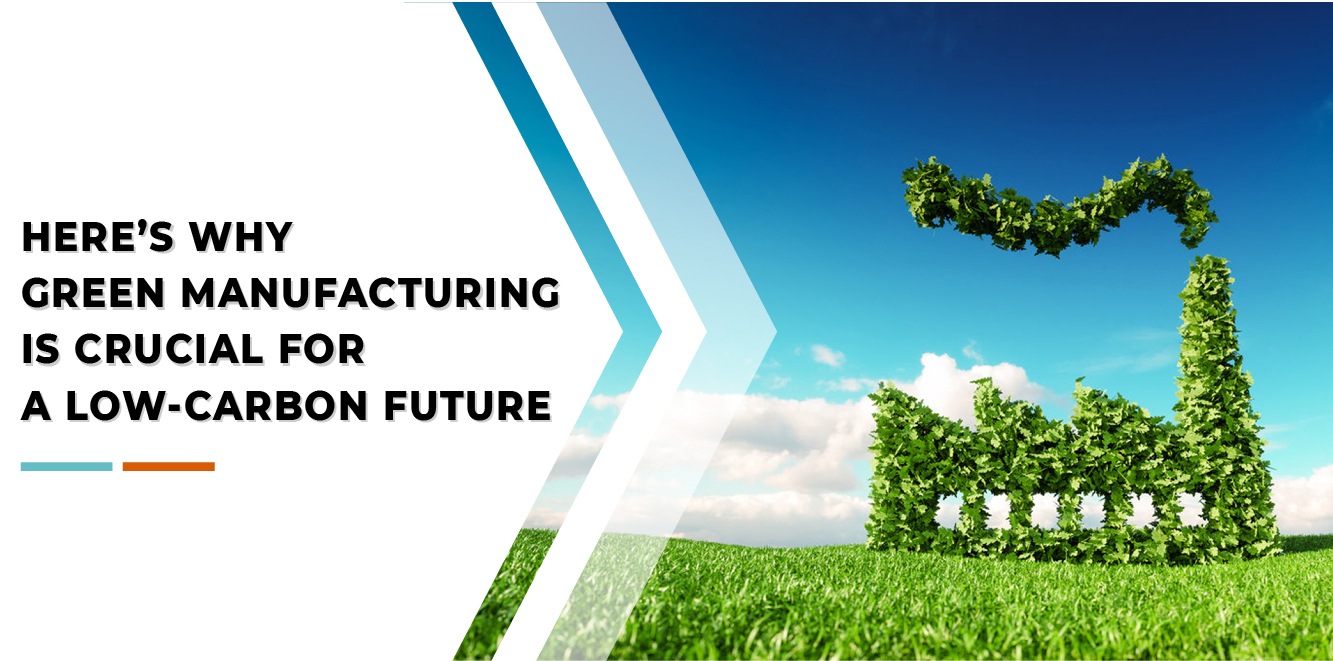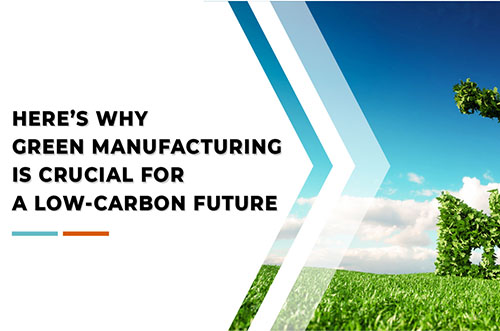
How do we strive for industrial growth while also being mindful of the traditional environmental impact of production?
We must find the right balance. Without a doubt, the time for change is now. Green manufacturing, an emerging industrial trend with an achievable, long-term future for sustainability, addresses these environmental challenges at a systemic level. It answers the call to action.

In short, green manufacturing is primarily about changing business and manufacturing practices, as well as the mindset of stakeholders, to mitigate the industrial impact on climate change and other environmental concerns.

The Fourth Industrial Revolution and Industrial Internet of Things (IIOT) present new opportunities to unlock process innovations to develop sustainable, environmentally-friendly materials; decarbonize energy; tap digital innovation for doing more with less; and extend the life cycle of goods within a “zero waste to landfill” framework.


- Reduced use of natural resources and energy;

- A lower carbon footprint worldwide;

- Technology advancements that optimize efficiency, resiliency, and sustainability across the full manufacturing life cycle, including the supply chain;

- The building of a strong foundation for a global circular economy.

There is significant potential to substitute carbon-intensive materials for less carbon-intensive ones. In the buildings sector at large, for example, it is possible to use timber or pozzolan – based concrete instead of Portland cement to mitigate pollution.
It is also possible to improve materials processing systems. For instance, in addition to using greener electronic materials such as innovative bio materials, electronic companies can now incorporate green packaging. A case in point is wheat straw packaging, which can lead to a 40% saving in energy and a 90% reduction in water required for production.

Companies can – and should – adopt eco-labeling to let consumers know where they stand. And in the coming years across manufacturing segments, look for blockchain advancements to improve green traceability.

The huge payoff of a green manufacturing approach is energy savings. Here, environmental and business benefits go hand-in-hand. We see a bright future for decarbonizing energy.
This goal can largely be achieved by the decarbonization of power and the electrification of processes. The cost of decarbonization can also be reduced significantly by constraining demand growth for carbon-intensive transport.
With digitized process innovation, even energy-demanding industries such as concrete production can push toward more efficient, climate-friendly practices.

Thanks to IIoT technology and the development of smart, connected devices, manufacturers can prioritize resource efficiency projects alongside productivity goals. Connected assets throughout a facility can yield insights into real-time and historical energy use, enabling industrial enterprises to streamline energy and resources from a bottom-line perspective.

Green manufacturing is about more than leveraging high-tech materials production and pushing for energy-efficient practices. It requires a fundamental change in the journey of goods.
The green manufacturing journey, by contrast, is circular. It moves beyond the 3R approach of “reduce, reuse, recycle” toward a 5R approach: “repair, reuse, refurbish, re-manufacture, and recycle” thereby driving an optimized usage of the resources and an extended life of products. Achieving “zero waste to landfill” is possible.

For example: Using a secondary resource as recycled aluminium, can produce up to 95 percent less CO2 emissions than using the raw material for the first time. If building constructors used recyclable, sustainable materials instead of single-use materials we could see a significant decrease in the industry’s carbon footprint.

When it comes to making meaningful change, we all are in it together. An extended enterprise approach is essential.

Let me be clear: green manufacturing is simply good business. It offers revolutionary advances in productivity and efficiency without the downsides of waste or pollution. Economic growth can and must be decoupled from environmental degradation.
The true power of green manufacturing will reveal itself when the entire industry begins to detach one from the other, thus accelerating the planet toward a low-carbon reality. This green mission is possible.
According to weforum.org
Author: Jean-Pascal Tricoire/b>

How do we strive for industrial growth while also being mindful of the traditional environmental impact of production?
We must find the right balance. Without a doubt, the time for change is now. Green manufacturing, an emerging industrial trend with an achievable, long-term future for sustainability, addresses these environmental challenges at a systemic level. It answers the call to action.

In short, green manufacturing is primarily about changing business and manufacturing practices, as well as the mindset of stakeholders, to mitigate the industrial impact on climate change and other environmental concerns.

The Fourth Industrial Revolution and Industrial Internet of Things (IIOT) present new opportunities to unlock process innovations to develop sustainable, environmentally-friendly materials; decarbonize energy; tap digital innovation for doing more with less; and extend the life cycle of goods within a “zero waste to landfill” framework.


- Reduced use of natural resources and energy;

- A lower carbon footprint worldwide;

- Technology advancements that optimize efficiency, resiliency, and sustainability across the full manufacturing life cycle, including the supply chain;

- The building of a strong foundation for a global circular economy.

There is significant potential to substitute carbon-intensive materials for less carbon-intensive ones. In the buildings sector at large, for example, it is possible to use timber or pozzolan – based concrete instead of Portland cement to mitigate pollution.
It is also possible to improve materials processing systems. For instance, in addition to using greener electronic materials such as innovative bio materials, electronic companies can now incorporate green packaging. A case in point is wheat straw packaging, which can lead to a 40% saving in energy and a 90% reduction in water required for production.

Companies can – and should – adopt eco-labeling to let consumers know where they stand. And in the coming years across manufacturing segments, look for blockchain advancements to improve green traceability.

The huge payoff of a green manufacturing approach is energy savings. Here, environmental and business benefits go hand-in-hand. We see a bright future for decarbonizing energy.
This goal can largely be achieved by the decarbonization of power and the electrification of processes. The cost of decarbonization can also be reduced significantly by constraining demand growth for carbon-intensive transport.
With digitized process innovation, even energy-demanding industries such as concrete production can push toward more efficient, climate-friendly practices.

Thanks to IIoT technology and the development of smart, connected devices, manufacturers can prioritize resource efficiency projects alongside productivity goals. Connected assets throughout a facility can yield insights into real-time and historical energy use, enabling industrial enterprises to streamline energy and resources from a bottom-line perspective.

Green manufacturing is about more than leveraging high-tech materials production and pushing for energy-efficient practices. It requires a fundamental change in the journey of goods.
The green manufacturing journey, by contrast, is circular. It moves beyond the 3R approach of “reduce, reuse, recycle” toward a 5R approach: “repair, reuse, refurbish, re-manufacture, and recycle” thereby driving an optimized usage of the resources and an extended life of products. Achieving “zero waste to landfill” is possible.

For example: Using a secondary resource as recycled aluminium, can produce up to 95 percent less CO2 emissions than using the raw material for the first time. If building constructors used recyclable, sustainable materials instead of single-use materials we could see a significant decrease in the industry’s carbon footprint.

When it comes to making meaningful change, we all are in it together. An extended enterprise approach is essential.

Let me be clear: green manufacturing is simply good business. It offers revolutionary advances in productivity and efficiency without the downsides of waste or pollution. Economic growth can and must be decoupled from environmental degradation.
The true power of green manufacturing will reveal itself when the entire industry begins to detach one from the other, thus accelerating the planet toward a low-carbon reality. This green mission is possible.
According to weforum.org
Author: Jean-Pascal Tricoire/b>










